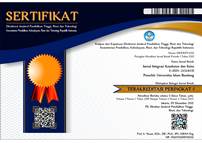Karakteristik Nevus Pigmentosus berdasar atas Gambaran Histopatologi di Rumah Sakit Al-Islam Bandung
Abstract
Nevus pigmentosus (NP) merupakan lesi melanositik jinak yang paling umum, puncaknya pada usia 25 sampai 26 tahun. Faktor yang memengaruhinya di antaranya penuaan, pubertas, kehamilan, penggunaan kortikosteroid sistemik, faktor genetik, lingkungan, usia, dan jenis kelamin. Tujuan penelitian ini mengetahui karakteristik pasien NP berdasar atas gambaran histopatologi di Rumah Sakit Al-Islam Bandung. Penelitian ini menggunakan metode deskriptif cross-sectional menggunakan metode pengambilan sampel berupa total sampling. Data yang digunakan berupa data sekunder dari rekam medis periode 2012−2017 dan didapatkan data berjumlah 48 rekam medis. Pengolahan data dilakukan menggunakan program Microsoft Exel tahun 2011. Hasil penelitian menunjukkan frekuensi tertinggi NP terdapat pada usia 25−45 tahun sebanyak 23 kasus (48%), NP lebih sering terjadi pada perempuan dibanding dengan laki-laki, nevus intradermal dengan jumlah 38 kasus (79%), dan regio kepala dengan frekuensi 39 kasus (81%). Perkembangan NP pada usia dewasa dapat disebabkan oleh beberapa kemungkinan di antaranya paparan sinar matahari, sering melakukan aktivitas di luar lingkungan, dan kurang penggunaan sunblock. Efek paparan sinar matahari secara langsung dapat menyebabkan proses melanogensis melalui aktivasi tirosinase akibat teraktivasinya protein kinase C. Simpulan penelitian ini menunjukkan frekuensi tertinggi NP terdapat pada usia 25−45 tahun dengan perbandingan perempuan lebih banyak dibanding laki-laki, serta gambaran histopatologi yang terbanyak adalah nevus intradermal yang berlokasi di regio kepala.
THE CHARACTERISTIC OF NEVUS PIGMENTOSUS BASED ON HISTOPATOLOGICAL FEATURES IN AL-ISLAM HOSPITAL BANDUNG
Nevus pigmentosus (NP) is the most common benign melanocytic lesion and peak at 25 to 26 years of age. The factors that influence NP is included aging, puberty, pregnancy, the used of systemic corticosteroid, genetic factors, environment, age, and gender. The purpose of this study was to describe the characteristics of NP patients based on histopathological features at Al-Islam Hospital Bandung. This study used a cross-sectional descriptive method using a total sampling method to collect the samples. The data used in this study is a secondary data from medical records 2012−2017 and obtained 48 medical records. Data processed by using the Microsoft Excel program 2011. The results showed that the highest frequency of NP occurred at the age of 25−45 years as many as 23 cases (48%), NP is more common in women rather than men, nevus intradermal with 38 cases (79%), and the head region with a frequency of 39 cases (81%). The progression of NP in adult can be caused by several possibilities including sun exposure, frequent activities outside the environment and lack use of sunblock. The effects of direct sunlight exposure can cause the melanogenesis process through activation of tyrosinase due to activation of protein kinase C. The conclusions in this study showed that the highest frequency of NP is found at the age of 25−45 years old with a ratio of women is more than men, and the highest number of the histopathological features is intradermal nevus located in the head region.
Keywords
Full Text:
PDFReferences
Kariosentono H. Tinjauan pustaka: neoplasma jinak dan hiperplasia melanosit. MDVI. 2013;40(3):145−52.
Sinikumpu SP, Huilaja L, Jokelainen J, Auvinen J, Timonen M, Tasanen K. Association of multiple melanocytic naevi with education, sex and skin type. A Northern Finland Birth Cohort 1966 Study with 46 years follow-up. Acta Derm Venereol. 2017;97(2):219−24.
Rammel K. Classification of melanocytic nevi. Medical University of Graz, 2017 [diunduh 01 Februari 2018]. Tersedia dari: https://online.medunigraz.at/mug_online/wbabs.get Document?pThesisNr=53571&pAutorNr=79751&pOrgNR=1.
Black S, MacDonald-Mcmillan B, Mallett X, Rynn C, Jackson G. The incidence and position of melanocytic nevi for the purposes of forensic image comparison. Int J Legal Med. 2014;128(3):535−43.
Pagliarello C, Stanganelli I, Zambito-Spadaro F, Feliciani C, Nuzzo S. Sex differences in axial and limb distribution of melanocytic naevi. Acta Derm Venereol. 2017;97(2):266−7.
Sugiura K, Sugiura M. Pigmented nevus. J Clin Exp Dermatol Res. 2015;6(1):1−5.
Tsaniyah RAD, Aspitriani, Fatmawati. Prevalensi dan gambaran histopatologi nevus pigmentosus di bagian patologi anatomi Rumah Sakit Dr. Mohammad Hoesin Palembang periode 1 Januari 2009–31 Desember 2013. MKS. 2015;47(2):110−4.
İyidal AY, Gül Ü, Kılıç A. Number and size of acquired melanocytic nevi and affecting risk factors in cases admitted to the dermatology clinic. Postepy Dermatol Alergol. 2016;33(5):375–80.
Goldsmith LA, Katz SI, Gilchrest BA, Paller AS, Leffell DJ, Wolff K. Fitzpatrick dermatology in general medicine. Edisi ke-8. New York: McGraw-Hill; 2012.
Suryaningsih BE, Soebono H. Tinjauan pustaka: biologi melanosit. MDVI. 2016;43(2):78–82.
McCalmont T. Melanocytic nevi. 2016 [diunduh 23 Desember 2017]. Tersedia dari: https://emedicine.medscape.com/article/1058445-over view.
Sumit K, Ajay K, Varna SP. Pregnancy and skin. J Obstet Gynecol India. 2012;62(3):268–75.
Mescher AL. Junqueira’s basic histology text & atlas. Edisi ke-14. New York: McGraw-Hill Education; 2016.
Kumar V, Abbas A, Aster J. Robbins basic pathology. Edisi ke-9. Philadelphia: Elsevier; 2013.
Oliveria SA, Scope A, Satagopan JM, Geller AC, Dusza SW, Weinstock MA, dkk. Factors associated with nevus volatility in early adolescence. J Invest Dermatol. 2014;134(9):2469−71.
DOI: https://doi.org/10.29313/jiks.v1i1.4327
Refbacks
- There are currently no refbacks.
Jurnal Integrasi Kesehatan dan Sains is licensed under a Creative Commons Attribution-NonCommercial-ShareAlike 4.0 International License.







.png)
_(1).png)




















